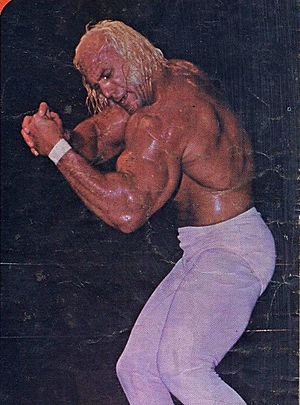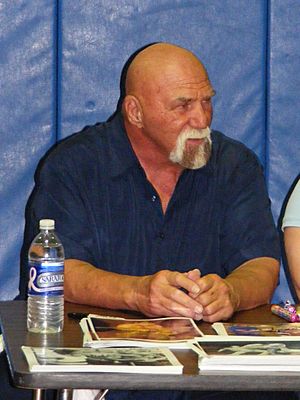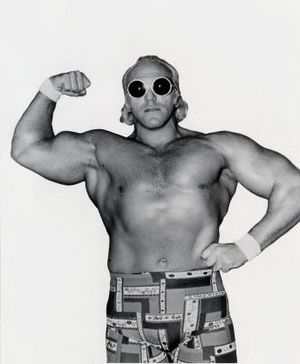"Superstar" Billy Graham facts for kids
Quick facts for kids "Superstar" Billy Graham |
|
|---|---|

Graham in 1975
|
|
| Birth name | Eldridge Wayne Coleman Jr. |
| Born | June 7, 1943 Phoenix, Arizona, U.S. |
| Died | May 17, 2023 (aged 79) Phoenix, Arizona, U.S. |
| Spouse(s) |
Valerie Coleman
(m. 1979) |
| Children | 2 |
| Professional wrestling career | |
| Ring name(s) | Billy Graham Wayne Coleman |
| Billed height | 6 ft 4 in (193 cm) |
| Billed weight | 275 lb (125 kg) |
| Billed from | Paradise Valley, Arizona, U.S. |
| Trained by | Stu Hart |
| Debut | 1970 |
| Retired | 1987 |
Eldridge Wayne Coleman Jr. (born June 7, 1943 – died May 17, 2023) was an American professional wrestler. He was better known by his ring name, "Superstar" Billy Graham. He became very famous as the WWWF Heavyweight Champion from 1977 to 1978. He won three world championships in major wrestling companies.
Billy Graham was also a talented bodybuilder. He trained with and was a close friend of Arnold Schwarzenegger. He is remembered for changing how wrestlers gave interviews and how they looked physically. He also had a very exciting and charismatic (charming) way of performing.
Contents
Early Life and Sports
Coleman was born in Phoenix, Arizona, on June 7, 1943. His family was working-class. His father worked for a power company, and his mother had Cherokee ancestry.
From a young age, Coleman loved lifting weights. As a teenager, he read many bodybuilding magazines. His heroes were famous bodybuilders like Steve Reeves and John Grimek. He also became a Christian and used his strength in religious meetings.
Coleman went to North High School. He was a star in track and field and a champion in shot put. He also tried boxing, taking part in the 1959 Golden Gloves. Later, at age 26, he tried out for the Canadian Football League. He played a few games for the Montreal Alouettes. He also worked as a bouncer in nightclubs.
Bodybuilding Achievements
In 1961, Coleman won the West Coast part of the Mr. Teenage America bodybuilding contest. His picture soon appeared in a fitness magazine. In 1968, he started training hard at Gold's Gym in Santa Monica. He worked out with famous bodybuilders like Dave Draper and Arnold Schwarzenegger. At this time, he could lift 605 pounds in a bench press.
Two years later, Coleman decided to become a professional wrestler. He wanted to combine wrestling with bodybuilding. He kept weight-training while wrestling. In 1975, he won first place for "Best Developed Arms" in a bodybuilding contest. His biceps were 22 inches big!
At his peak in wrestling in 1977, Coleman weighed 275 pounds. In 1980, he weighed 325 pounds and took part in the World's Strongest Man competition. He finished seventh, even though he got hurt during one event.
Professional Wrestling Career
Starting Out (1969–1972)
In 1969, another wrestler, Bob Lueck, told Coleman to train with Stu Hart. Hart ran a wrestling company called Stampede Wrestling. Coleman started wrestling in January 1970. He first wrestled under his real name.
Later, he joined a team with Dr. Jerry Graham in Los Angeles. He changed his ring name to Billy Graham. This was a tribute to the famous religious leader of the same name. Jerry also told him to dye his hair blonde. While wrestling in Florida, he was presented as Jerry's younger brother.
In California, Billy Graham added new parts to his character. Before matches, he would have arm wrestling contests. He would challenge people to try and beat him as the "Arm Wrestling Champion of the World."
American Wrestling Association (1972–1975)
During his time with the AWA, Graham had many rivalries, called feuds. He wrestled against stars like The Crusher and Wahoo McDaniel. He also teamed up with Ivan Koloff.
Graham started adding more to his performances. He did arm wrestling contests, weightlifting challenges, and posing routines. One of his most famous rivalries was against Wahoo McDaniel. They had many intense matches.
In 1974, Graham went to Japan for a wrestling tour. After returning, he formed a tag team with Dusty Rhodes. He later left the AWA and returned to the NWA.
World Wide Wrestling Federation (1975–1978)
Graham first wrestled in the World Wide Wrestling Federation (WWWF) in October 1975. He teamed up with Spiros Arion to defeat WWWF Heavyweight Champion Bruno Sammartino and Dominic De Nucci. During this time, The Grand Wizard became Graham's manager.
After a short time in other companies, Graham returned to the WWWF. On April 30, 1977, he defeated Bruno Sammartino to win the WWWF Heavyweight Championship. He won by putting his feet on the ropes for extra leverage.
As champion, he wrestled across America and Japan. He faced many challengers like Bruno Sammartino, Dusty Rhodes, and Pedro Morales. On January 25, 1978, Graham wrestled against the NWA World Heavyweight Champion, Harley Race. This match was to unify (combine) the two world titles, but it ended in a one-hour draw.
Graham eventually lost his title to Bob Backlund on February 20, 1978. He also had a big rivalry with Dusty Rhodes, which included a Texas Bullrope match.
Later Career (1978–1989)
After losing his title, Graham left the WWWF in December 1978. He wrestled for other companies like the NWA. In October 1979, he became the Continental Wrestling Association (CWA) World Champion.
In 1982, Graham returned to the now-renamed World Wrestling Federation (WWF). He had a new look: a bald head, a mustache, and black karate pants. He challenged Bob Backlund for the WWF Championship but could not win it.
Graham returned to the AWA and NWA in the mid-1980s. He gained back his muscle size and returned to his famous tie-dyed look. He also grew a goatee and dyed his mustache blonde.
His final return to the WWF was in 1986. He was now a fan favorite, meaning fans cheered for him. He needed hip replacement surgery, which was even shown on WWF TV. He tried to return to wrestling in 1987, but his injuries were too much. He officially retired from active wrestling. After that, he worked as a commentator for the WWF.
WWE Hall of Fame (2004–2023)
On March 14, 2004, Billy Graham was inducted into the WWE Hall of Fame. This was the night before WrestleMania XX. Triple H, a famous wrestler whom Graham had inspired, inducted him.
Graham later sold his WWE Hall of Fame ring. He did this to buy medicine for his liver transplant. He made several appearances for WWE between 2004 and 2006. He promoted his book and DVD. He signed a new "legends contract" with WWE in 2015, which meant he would make occasional appearances.
Legacy and Influence
Many people in wrestling believe Billy Graham changed the industry. Dave Meltzer, a wrestling journalist, said that without Graham, wrestling would be very different. Graham was very popular because of his skill, strength, and colorful personality. He sold out 19 shows at Madison Square Garden, which was a major achievement.
Many famous wrestlers were inspired by Billy Graham's look and style. These include Ric Flair, Hulk Hogan, Triple H, and Jesse "The Body" Ventura. Graham was also known for saying "brother" a lot in his interviews. This came from his religious background. His use of the word became popular, and many wrestlers, especially Hulk Hogan, started using it too.
Graham often talked to young athletes about the dangers of anabolic steroids. He wrote an autobiography called Tangled Ropes, which came out in 2006. WWE also released a DVD about his career.
Personal Life
Family
Billy Graham and his wife, Valerie Belkas, married in 1978. They did not have children together. Graham had two children from an earlier marriage: a daughter named Capella (born 1972) and a son named Joey (born 1975). Joey was born with some health issues that were later corrected.
Health Challenges and Death
Graham faced many health problems throughout his life. He got hepatitis C and received a liver transplant in 2002. The new liver came from a 26-year-old woman who died in a car crash.
He was hospitalized several times for liver problems and other issues. In 2010, he thought he might only have a year to live without another liver transplant. In 2013, he was hospitalized with pneumonia and possible heart failure. In 2022, he needed to have his toes amputated.
Billy Graham was hospitalized in January 2023 with an ear and skull infection. His health got worse, and he lost a lot of weight. He was treated for kidney, heart, and lung problems. He passed away on May 17, 2023, from sepsis and multiple organ failure. He was almost 80 years old.
Championships and Awards
Billy Graham won many championships and awards during his wrestling career:
- 50th State Big Time Wrestling
- NWA Hawaii Heavyweight Championship (1 time)
- Championship Wrestling from Florida
- NWA Florida Heavyweight Championship (2 times)
- NWA Florida Tag Team Championship (1 time) – with Ox Baker
- NWA Southern Heavyweight Championship (Florida version) (1 time)
- Continental Wrestling Association
- CWA World Heavyweight Championship (1 time)
- International Pro Wrestling
- IWA World Heavyweight Championship (1 time)
- NWA Big Time Wrestling
- NWA Brass Knuckles Championship (Texas version) (4 times)
- NWA San Francisco
- NWA World Tag Team Championship (San Francisco version) (1 time) – with Pat Patterson
- Pro Wrestling Illustrated
- Most Hated Wrestler of the Year (1973)
- Match of the Year (1977) vs. Bruno Sammartino
- Match of the Year (1978) vs. Bob Backlund
- Professional Wrestling Hall of Fame and Museum
- Class of 2009
- World (Wide) Wrestling Federation / Entertainment
- WWWF Heavyweight Championship (1 time)
- WWE Hall of Fame (Class of 2004)
- Slammy Award (1 time)
- Hulk Hogan Real American Award (1987)
- Wrestling Observer Newsletter
- Best Pro Wrestling Book (2006)
- Wrestling Observer Newsletter Hall of Fame (Class of 1996)
Images for kids
See also
 In Spanish: Superstar Billy Graham para niños
In Spanish: Superstar Billy Graham para niños






